Indie rock is a subgenre of rock music that originated in the United Kingdom, United States and New Zealand in the early to mid-1980s. Although the term was originally used to describe rock music released through independent record labels, by the 1990s it became more widely associated with the music such bands produced.
Alternative rock is a category of rock music that evolved from the independent music underground of the 1970s. Alternative rock acts achieved mainstream success in the 1990s with the likes of the grunge, shoegaze, and Britpop subgenres in the United States and United Kingdom, respectively. During this period, many record labels were looking for "alternatives", as many corporate rock, hard rock, and glam metal acts from the 1980s were beginning to grow stale throughout the music industry. The emergence of Generation X as a cultural force in the 1990s also contributed greatly to the rise of alternative rock.

The music of South Korea has evolved over the course of the decades since the end of the Korean War, and has its roots in the music of the Korean people, who have inhabited the Korean peninsula for over a millennium. Contemporary South Korean music can be divided into three different main categories: Traditional Korean folk music, popular music, or K-pop, and Western-influenced non-popular music.
Korean hip-hop, also known as K-hip-hop or K-rap, is a subgenre of the South Korean popular music.

Hongdae is a neighborhood in Seoul, South Korea near Hongik University, after which it is named. It is known for its urban arts and indie music culture, local shops, clubs, cafés and entertainment. The area is located in Mapo District in the western end of Seoul, stretching from Seogyo-dong, Hapjeong-dong & Seogang-dong.
An independent music scene is a localized independent music-oriented community of bands and their audiences. Local scenes can play a key role in musical history and lead to the development of influential genres; for example, no wave from New York City, Madchester from Manchester, and grunge from Seattle.

Crying Nut (Korean: 크라잉넛) is a punk band from South Korea. They are often credited as being pioneers of the Korean punk and indie rock scenes.
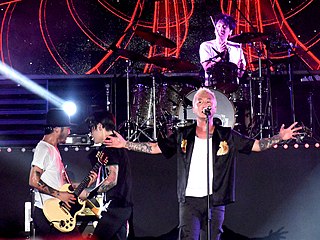
No Brain is a South Korean punk rock band widely considered one of the godfathers of the Korean punk scene. Originally part of Korea's homegrown underground punk movement, known as Chosun Punk, in recent years the group has enjoyed mainstream success both with their music and their emerging acting and hosting careers. Their name comes from their desire for concert-goers to leave their rational minds at the venue doors.
Korean rock is rock music from South Korea. It has roots in American rock, which was imported to South Korea by U.S. soldiers fighting in the Korean War and stationing in U.S. military bases in South Korea after the war. Around the U.S. military bases, local musicians could have opportunities to learn American rock music and perform it on stage for U.S. soldiers. As a result, many Korean rock bands, called Vocal Bands or Group Sound, started their musical careers in the 1960s. Under the military administration in the 1970s, rock music and its subculture were classified as a depraved youth culture and restricted. After the Korean Fifth Republic, the censorship policies under the military government were abolished and rock music became a mainstream genre in South Korea until the end of the 1980s. Today, rock music is not the main genre in the music market in South Korea, but it still occupies a big portion of music consumption in the nation.
Alternative dance is a musical genre that mixes alternative rock with electronic dance music. Although largely confined to the British Isles, it has gained American and worldwide exposure through acts such as New Order in the 1980s and the Prodigy in the 1990s.

Rux is an influential street punk band from South Korea. They formed in 1996 and released their first recording in 1999. Lead vocalist Won Jong-hee, the only remaining original member, also ran Skunk Label and owned the punk music venue Skunk Hell. They gained notoriety in 2005 when friends of the band undressed on stage during the live nationwide broadcast of an episode of MBC concert show Music Camp.

Kingston Rudieska(킹스턴 루디스카) is a nine-piece South Korean ska band formed in 2004. Their sound is mainly influenced by first-wave Jamaican ska, as well as other Caribbean genres including reggae and calypso music. They are heavily influenced by the Skatalites and frequently perform Skatalites covers. Many of the members are jazz musicians, and their sound is heavily influenced by ska jazz, with band members frequently performing solos during performances.
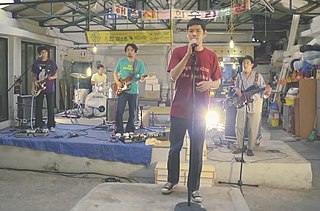
Chang Kiha is a South Korean singer-songwriter, actor, essay writer and radio host. He is best known as the lead singer of the indie rock band Kiha & The Faces.

Kiha & The Faces was a South Korean indie rock band led by singer Chang Kiha. The band debuted in 2008 with the single, "Cheap Coffee," and have since become one of South Korea's most popular and commercially successful indie rock bands.
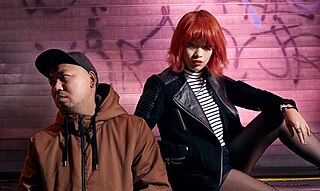
Love X Stereo is an electro duo from Seoul, Korea. Consisting lead vocalist and synthesizer player Annie Ko and guitarist and producer Toby Hwang, the duo debuted in 2011 by releasing an EP album called Buzzin'.
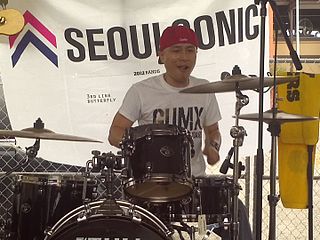
Seoulsonic (SEOULSONIC), is an annual concert tour in the United States and Canada, organized by the DFSB Kollective with support from the Korea Creative Content Agency (KOCCA), which began in 2011 in an effort to introduce South Korea's indie music culture to the West. The tour includes annual stops at SXSW in Austin, Texas and the Canadian Music Week in Toronto, Canada.
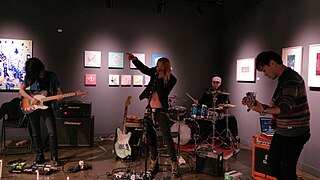
Whang Bo-ryung = Smacksoft, commonly known as Smacksoft, is a South Korean post-punk and experimental rock band formed in 2000 by the lead singer-songwriter Whang Bo-ryung.
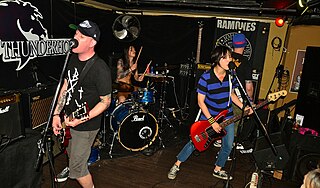
...Whatever That Means is a South Korean melodic punk band based in Seoul, South Korea. Alternative Press called them the "pop-punk face of the Korean music scene." The two key members are married couple Jeff and Trash. Both are promoters who have organized concerts and brought foreign bands to Korea. They organize annual Halloween shows and previously managed the monthly 2nd Saturdays concert series. They have been associated closely with the venues Club Spot, Ruailrock, Club SHARP, and Thunderhorse Tavern.

The Solutions (솔루션스) is a South Korean indie rock band under the label Happy Robot Records. They originally debuted as a duo with Naru and Park Sol in June 2012 with the digital single "Sounds of the Universe" from their self-titled album The Solutions. Kwon Oh-kyung and Park Han-sol joined the band for their second album Movements in 2014, which included the work of Grammy award-winning recording engineer and producer Jimmy Douglass.
Zzzaam is a South Korean shoegaze band. The band currently consists of Choi Sohee, Park Seongwoo and Do Jaemyeong. Since their formation in 1997, the band has released 3 studio albums: Siesta (낮잠) (2000), Requiem #1 (2002) and Mirror Play (거울놀이) (2004).













